engine JEEP COMPASS 2020 Owner handbook (in English)
[x] Cancel search | Manufacturer: JEEP, Model Year: 2020, Model line: COMPASS, Model: JEEP COMPASS 2020Pages: 328, PDF Size: 8.85 MB
Page 204 of 328
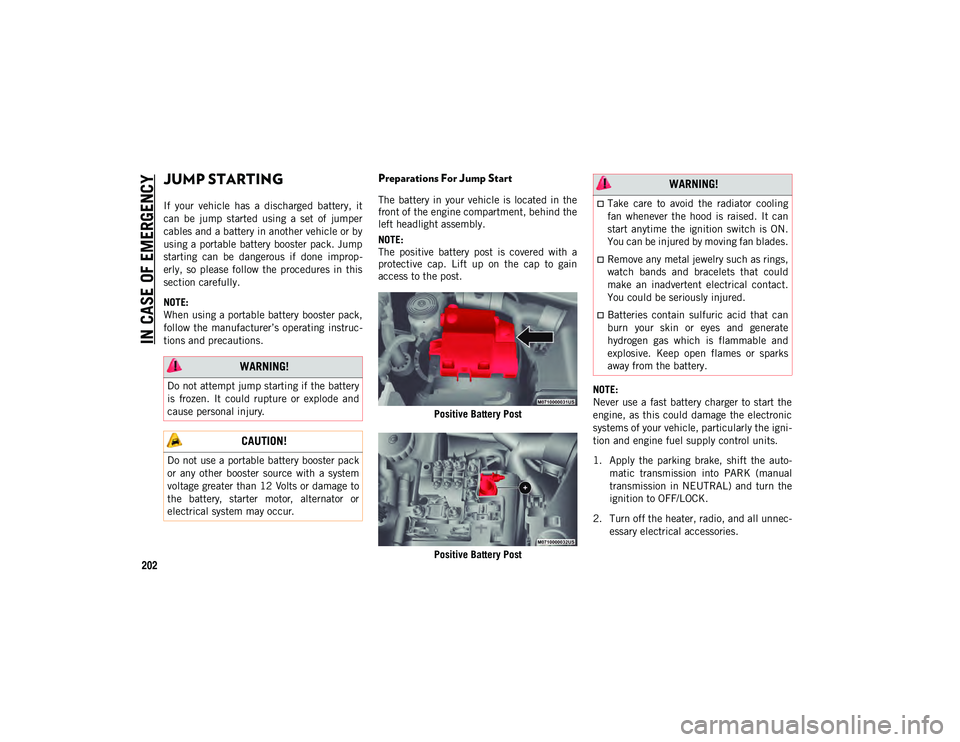
IN CASE OF EMERGENCY
202
JUMP STARTING
If your vehicle has a discharged battery, it
can be jump started using a set of jumper
cables and a battery in another vehicle or by
using a portable battery booster pack. Jump
starting can be dangerous if done improp-
erly, so please follow the procedures in this
section carefully.
NOTE:
When using a portable battery booster pack,
follow the manufacturer’s operating instruc -
tions and precautions.
Preparations For Jump Start
The battery in your vehicle is located in the
front of the engine compartment, behind the
left headlight assembly.
NOTE:
The positive battery post is covered with a
protective cap. Lift up on the cap to gain
access to the post.
Positive Battery Post
Positive Battery Post NOTE:
Never use a fast battery charger to start the
engine, as this could damage the electronic
systems of your vehicle, particularly the igni
-
tion and engine fuel supply control units.
1. Apply the parking brake, shift the auto -
matic transmission into PARK (manual
transmission in NEUTRAL) and turn the
ignition to OFF/LOCK.
2. Turn off the heater, radio, and all unnec -
essary electrical accessories.
WARNING!
Do not attempt jump starting if the battery
is frozen. It could rupture or explode and
cause personal injury.
CAUTION!
Do not use a portable battery booster pack
or any other booster source with a system
voltage greater than 12 Volts or damage to
the battery, starter motor, alternator or
electrical system may occur.
WARNING!
Take care to avoid the radiator cooling
fan whenever the hood is raised. It can
start anytime the ignition switch is ON.
You can be injured by moving fan blades.
Remove any metal jewelry such as rings,
watch bands and bracelets that could
make an inadvertent electrical contact.
You could be seriously injured.
Batteries contain sulfuric acid that can
burn your skin or eyes and generate
hydrogen gas which is flammable and
explosive. Keep open flames or sparks
away from the battery.
2020_JEEP_M6_UG_UK.book Page 202
Page 205 of 328
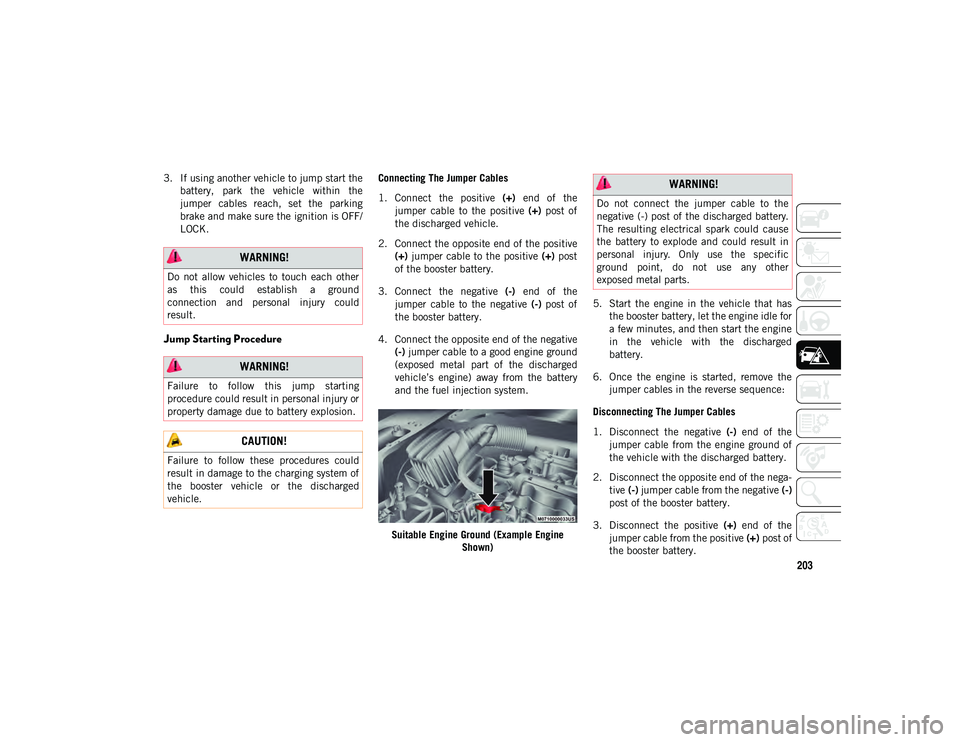
203
3. If using another vehicle to jump start thebattery, park the vehicle within the
jumper cables reach, set the parking
brake and make sure the ignition is OFF/
LOCK.
Jump Starting Procedure
Connecting The Jumper Cables
1. Connect the positive (+) end of the
jumper cable to the positive (+) post of
the discharged vehicle.
2. Connect the opposite end of the positive (+) jumper cable to the positive (+) post
of the booster battery.
3. Connect the negative (-) end of the
jumper cable to the negative (-) post of
the booster battery.
4. Connect the opposite end of the negative (-) jumper cable to a good engine ground
(exposed metal part of the discharged
vehicle’s engine) away from the battery
and the fuel injection system.
Suitable Engine Ground (Example Engine Shown) 5. Start the engine in the vehicle that has
the booster battery, let the engine idle for
a few minutes, and then start the engine
in the vehicle with the discharged
battery.
6. Once the engine is started, remove the jumper cables in the reverse sequence:
Disconnecting The Jumper Cables
1. Disconnect the negative (-) end of the
jumper cable from the engine ground of
the vehicle with the discharged battery.
2. Disconnect the opposite end of the nega -
tive (-) jumper cable from the negative (-)
post of the booster battery.
3. Disconnect the positive (+) end of the
jumper cable from the positive (+) post of
the booster battery.
WARNING!
Do not allow vehicles to touch each other
as this could establish a ground
connection and personal injury could
result.
WARNING!
Failure to follow this jump starting
procedure could result in personal injury or
property damage due to battery explosion.
CAUTION!
Failure to follow these procedures could
result in damage to the charging system of
the booster vehicle or the discharged
vehicle.
WARNING!
Do not connect the jumper cable to the
negative (-) post of the discharged battery.
The resulting electrical spark could cause
the battery to explode and could result in
personal injury. Only use the specific
ground point, do not use any other
exposed metal parts.
2020_JEEP_M6_UG_UK.book Page 203
Page 206 of 328
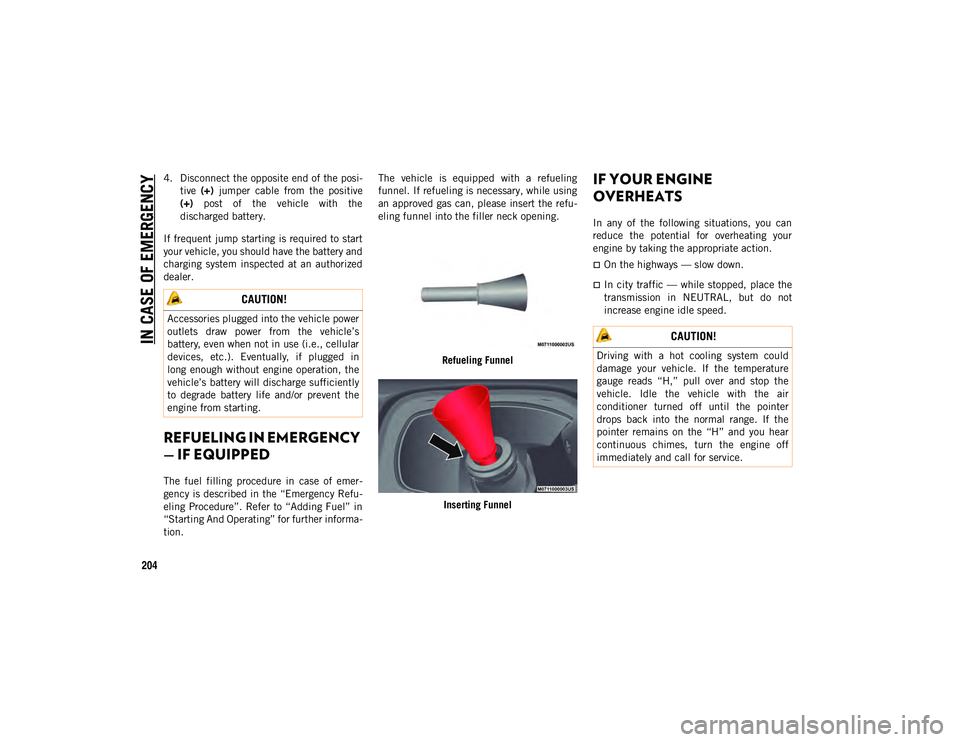
IN CASE OF EMERGENCY
204
4. Disconnect the opposite end of the posi-
tive (+) jumper cable from the positive
(+) post of the vehicle with the
discharged battery.
If frequent jump starting is required to start
your vehicle, you should have the battery and
charging system inspected at an authorized
dealer.
REFUELING IN EMERGENCY
— IF EQUIPPED
The fuel filling procedure in case of emer -
gency is described in the “Emergency Refu -
eling Procedure”. Refer to “Adding Fuel” in
“Starting And Operating” for further informa -
tion. The vehicle is equipped with a refueling
funnel. If refueling is necessary, while using
an approved gas can, please insert the refu
-
eling funnel into the filler neck opening.
Refueling Funnel
Inserting Funnel
IF YOUR ENGINE
OVERHEATS
In any of the following situations, you can
reduce the potential for overheating your
engine by taking the appropriate action.
On the highways — slow down.
In city traffic — while stopped, place the
transmission in NEUTRAL, but do not
increase engine idle speed.
CAUTION!
Accessories plugged into the vehicle power
outlets draw power from the vehicle’s
battery, even when not in use (i.e., cellular
devices, etc.). Eventually, if plugged in
long enough without engine operation, the
vehicle’s battery will discharge sufficiently
to degrade battery life and/or prevent the
engine from starting.
CAUTION!
Driving with a hot cooling system could
damage your vehicle. If the temperature
gauge reads “H,” pull over and stop the
vehicle. Idle the vehicle with the air
conditioner turned off until the pointer
drops back into the normal range. If the
pointer remains on the “H” and you hear
continuous chimes, turn the engine off
immediately and call for service.
2020_JEEP_M6_UG_UK.book Page 204
Page 207 of 328
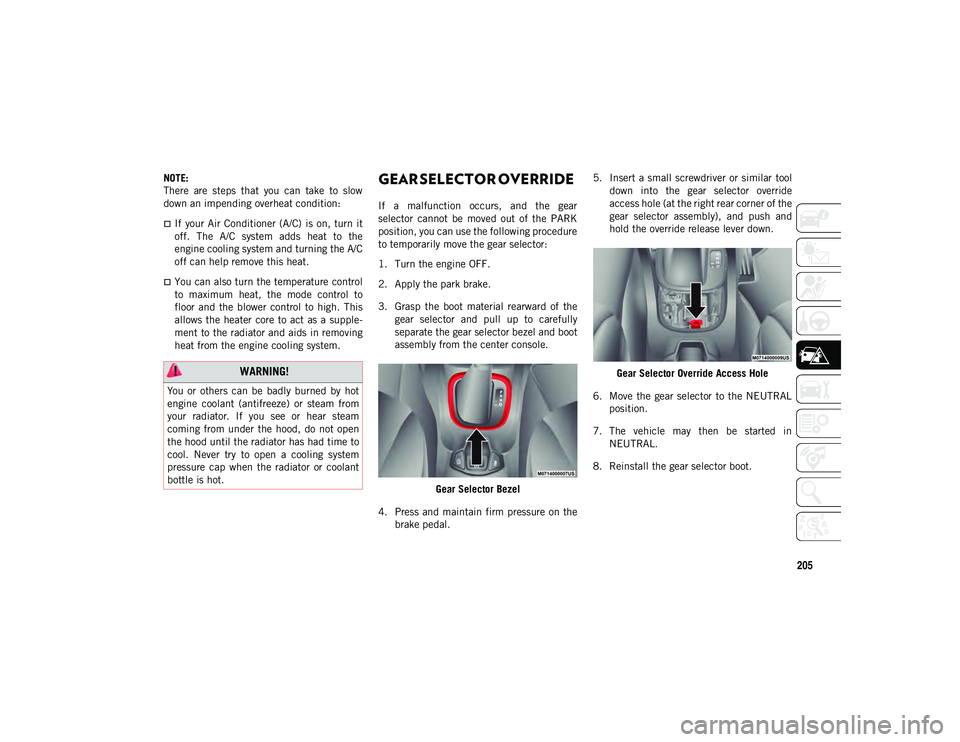
205
NOTE:
There are steps that you can take to slow
down an impending overheat condition:
If your Air Conditioner (A/C) is on, turn it
off. The A/C system adds heat to the
engine cooling system and turning the A/C
off can help remove this heat.
You can also turn the temperature control
to maximum heat, the mode control to
floor and the blower control to high. This
allows the heater core to act as a supple-
ment to the radiator and aids in removing
heat from the engine cooling system.
GEAR SELECTOR OVERRIDE
If a malfunction occurs, and the gear
selector cannot be moved out of the PARK
position, you can use the following procedure
to temporarily move the gear selector:
1. Turn the engine OFF.
2. Apply the park brake.
3. Grasp the boot material rearward of thegear selector and pull up to carefully
separate the gear selector bezel and boot
assembly from the center console.
Gear Selector Bezel
4. Press and maintain firm pressure on the brake pedal. 5. Insert a small screwdriver or similar tool
down into the gear selector override
access hole (at the right rear corner of the
gear selector assembly), and push and
hold the override release lever down.
Gear Selector Override Access Hole
6. Move the gear selector to the NEUTRAL position.
7. The vehicle may then be started in NEUTRAL.
8. Reinstall the gear selector boot.
WARNING!
You or others can be badly burned by hot
engine coolant (antifreeze) or steam from
your radiator. If you see or hear steam
coming from under the hood, do not open
the hood until the radiator has had time to
cool. Never try to open a cooling system
pressure cap when the radiator or coolant
bottle is hot.
2020_JEEP_M6_UG_UK.book Page 205
Page 208 of 328
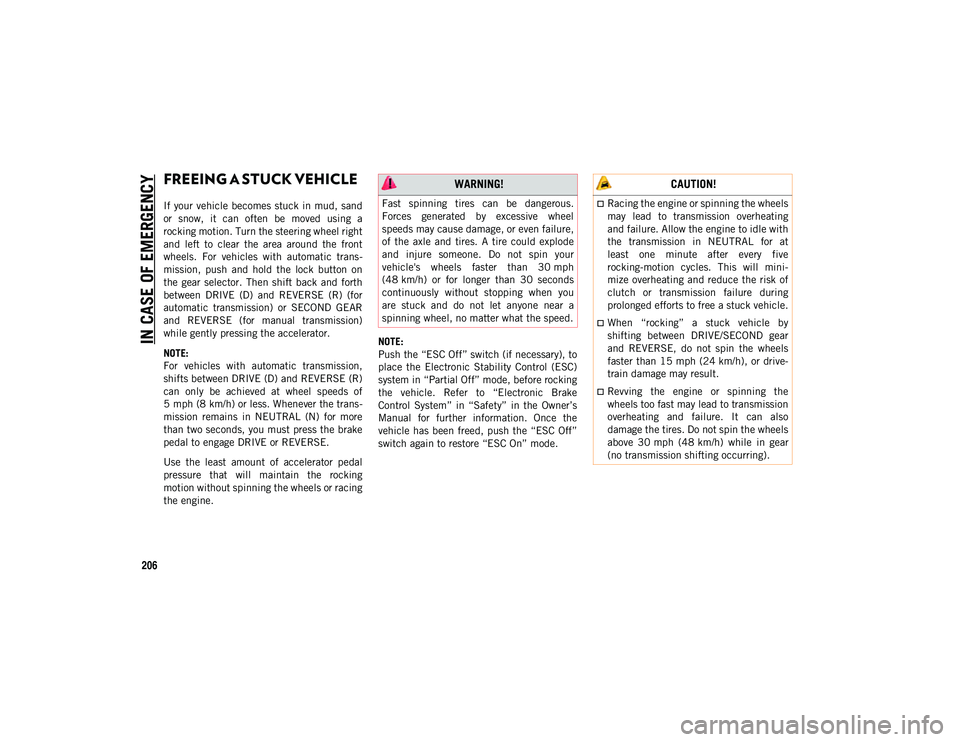
IN CASE OF EMERGENCY
206
FREEING A STUCK VEHICLE
If your vehicle becomes stuck in mud, sand
or snow, it can often be moved using a
rocking motion. Turn the steering wheel right
and left to clear the area around the front
wheels. For vehicles with automatic trans-
mission, push and hold the lock button on
the gear selector. Then shift back and forth
between DRIVE (D) and REVERSE (R) (for
automatic transmission) or SECOND GEAR
and REVERSE (for manual transmission)
while gently pressing the accelerator.
NOTE:
For vehicles with automatic transmission,
shifts between DRIVE (D) and REVERSE (R)
can only be achieved at wheel speeds of
5 mph (8 km/h) or less. Whenever the trans -
mission remains in NEUTRAL (N) for more
than two seconds, you must press the brake
pedal to engage DRIVE or REVERSE.
Use the least amount of accelerator pedal
pressure that will maintain the rocking
motion without spinning the wheels or racing
the engine. NOTE:
Push the “ESC Off” switch (if necessary), to
place the Electronic Stability Control (ESC)
system in “Partial Off” mode, before rocking
the vehicle. Refer to “Electronic Brake
Control System” in “Safety” in the Owner’s
Manual for further information. Once the
vehicle has been freed, push the “ESC Off”
switch again to restore “ESC On” mode.
WARNING!
Fast spinning tires can be dangerous.
Forces generated by excessive wheel
speeds may cause damage, or even failure,
of the axle and tires. A tire could explode
and injure someone. Do not spin your
vehicle's wheels faster than 30 mph
(48 km/h) or for longer than 30 seconds
continuously without stopping when you
are stuck and do not let anyone near a
spinning wheel, no matter what the speed.
CAUTION!
Racing the engine or spinning the wheels
may lead to transmission overheating
and failure. Allow the engine to idle with
the transmission in NEUTRAL for at
least one minute after every five
rocking-motion cycles. This will mini
-
mize overheating and reduce the risk of
clutch or transmission failure during
prolonged efforts to free a stuck vehicle.
When “rocking” a stuck vehicle by
shifting between DRIVE/SECOND gear
and REVERSE, do not spin the wheels
faster than 15 mph (24 km/h), or drive -
train damage may result.
Revving the engine or spinning the
wheels too fast may lead to transmission
overheating and failure. It can also
damage the tires. Do not spin the wheels
above 30 mph (48 km/h) while in gear
(no transmission shifting occurring).
2020_JEEP_M6_UG_UK.book Page 206
Page 210 of 328
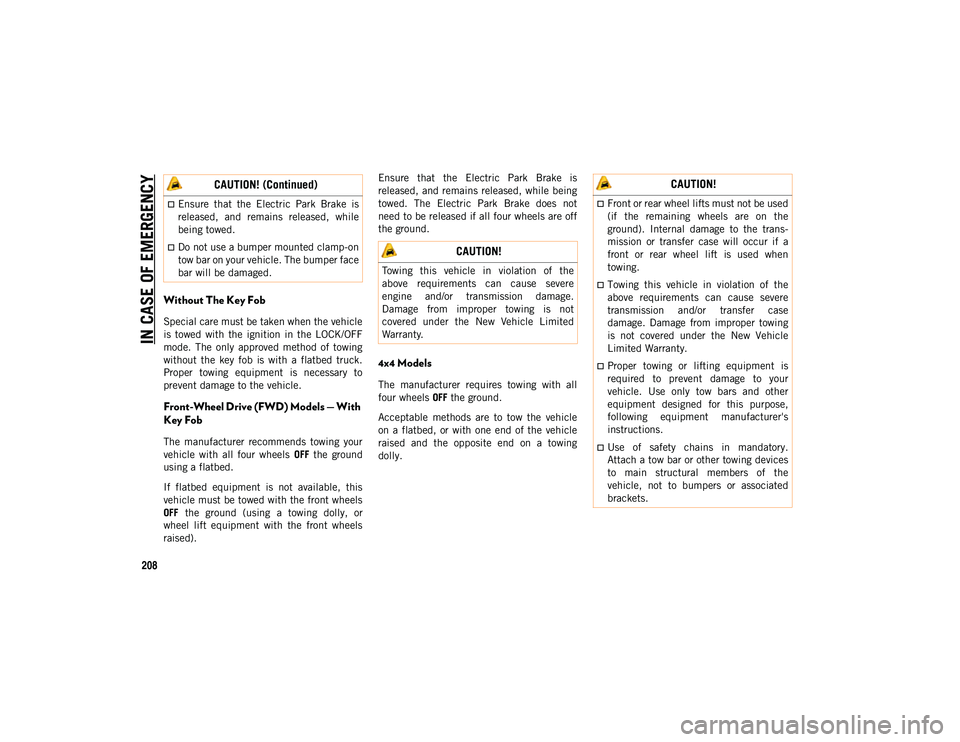
IN CASE OF EMERGENCY
208
Without The Key Fob
Special care must be taken when the vehicle
is towed with the ignition in the LOCK/OFF
mode. The only approved method of towing
without the key fob is with a flatbed truck.
Proper towing equipment is necessary to
prevent damage to the vehicle.
Front-Wheel Drive (FWD) Models — With
Key Fob
The manufacturer recommends towing your
vehicle with all four wheels OFF the ground
using a flatbed.
If flatbed equipment is not available, this
vehicle must be towed with the front wheels
OFF the ground (using a towing dolly, or
wheel lift equipment with the front wheels
raised). Ensure that the Electric Park Brake is
released, and remains released, while being
towed. The Electric Park Brake does not
need to be released if all four wheels are off
the ground.
4x4 Models
The manufacturer requires towing with all
four wheels
OFF the ground.
Acceptable methods are to tow the vehicle
on a flatbed, or with one end of the vehicle
raised and the opposite end on a towing
dolly.
Ensure that the Electric Park Brake is
released, and remains released, while
being towed.
Do not use a bumper mounted clamp-on
tow bar on your vehicle. The bumper face
bar will be damaged.
CAUTION! (Continued)
CAUTION!
Towing this vehicle in violation of the
above requirements can cause severe
engine and/or transmission damage.
Damage from improper towing is not
covered under the New Vehicle Limited
Warranty.
CAUTION!
Front or rear wheel lifts must not be used
(if the remaining wheels are on the
ground). Internal damage to the trans-
mission or transfer case will occur if a
front or rear wheel lift is used when
towing.
Towing this vehicle in violation of the
above requirements can cause severe
transmission and/or transfer case
damage. Damage from improper towing
is not covered under the New Vehicle
Limited Warranty.
Proper towing or lifting equipment is
required to prevent damage to your
vehicle. Use only tow bars and other
equipment designed for this purpose,
following equipment manufacturer's
instructions.
Use of safety chains in mandatory.
Attach a tow bar or other towing devices
to main structural members of the
vehicle, not to bumpers or associated
brackets.
2020_JEEP_M6_UG_UK.book Page 208
Page 212 of 328
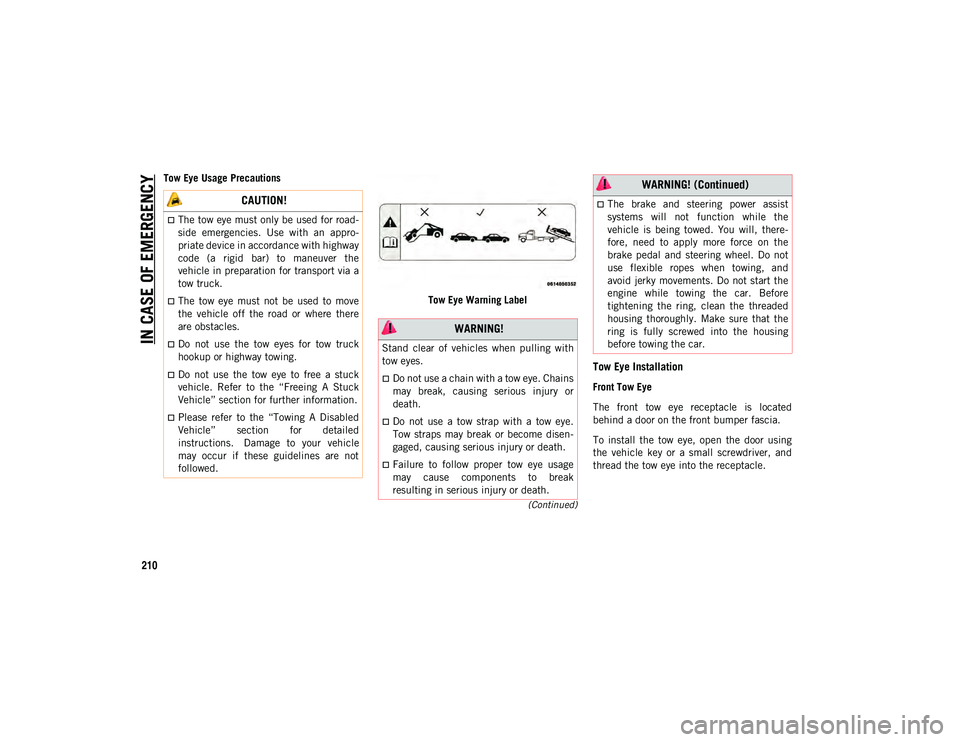
IN CASE OF EMERGENCY
210
(Continued)
Tow Eye Usage PrecautionsTow Eye Warning Label
Tow Eye Installation
Front Tow Eye
The front tow eye receptacle is located
behind a door on the front bumper fascia.
To install the tow eye, open the door using
the vehicle key or a small screwdriver, and
thread the tow eye into the receptacle.
CAUTION!
The tow eye must only be used for road-
side emergencies. Use with an appro-
priate device in accordance with highway
code (a rigid bar) to maneuver the
vehicle in preparation for transport via a
tow truck.
The tow eye must not be used to move
the vehicle off the road or where there
are obstacles.
Do not use the tow eyes for tow truck
hookup or highway towing.
Do not use the tow eye to free a stuck
vehicle. Refer to the “Freeing A Stuck
Vehicle” section for further information.
Please refer to the “Towing A Disabled
Vehicle” section for detailed
instructions. Damage to your vehicle
may occur if these guidelines are not
followed.
WARNING!
Stand clear of vehicles when pulling with
tow eyes.
Do not use a chain with a tow eye. Chains
may break, causing serious injury or
death.
Do not use a tow strap with a tow eye.
Tow straps may break or become disen -
gaged, causing serious injury or death.
Failure to follow proper tow eye usage
may cause components to break
resulting in serious injury or death.
The brake and steering power assist
systems will not function while the
vehicle is being towed. You will, there-
fore, need to apply more force on the
brake pedal and steering wheel. Do not
use flexible ropes when towing, and
avoid jerky movements. Do not start the
engine while towing the car. Before
tightening the ring, clean the threaded
housing thoroughly. Make sure that the
ring is fully screwed into the housing
before towing the car.
WARNING! (Continued)
2020_JEEP_M6_UG_UK.book Page 210
Page 214 of 328
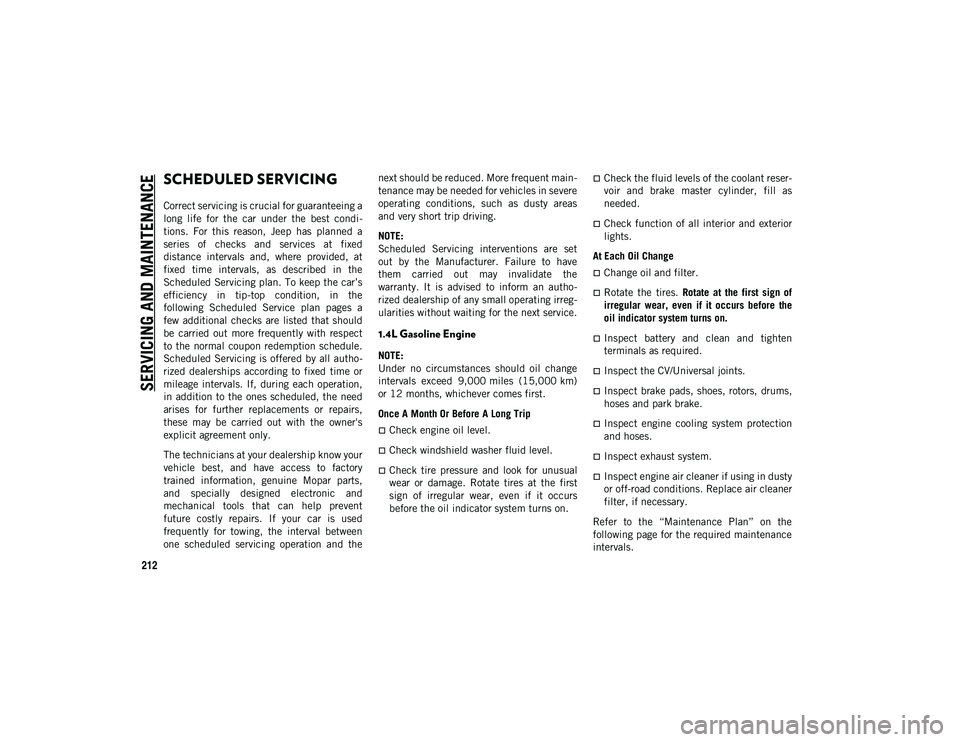
212
SERVICING AND MAINTENANCE
SCHEDULED SERVICING
Correct servicing is crucial for guaranteeing a
long life for the car under the best condi-
tions. For this reason, Jeep has planned a
series of checks and services at fixed
distance intervals and, where provided, at
fixed time intervals, as described in the
Scheduled Servicing plan. To keep the car’s
efficiency in tip-top condition, in the
following Scheduled Service plan pages a
few additional checks are listed that should
be carried out more frequently with respect
to the normal coupon redemption schedule.
Scheduled Servicing is offered by all autho -
rized dealerships according to fixed time or
mileage intervals. If, during each operation,
in addition to the ones scheduled, the need
arises for further replacements or repairs,
these may be carried out with the owner's
explicit agreement only.
The technicians at your dealership know your
vehicle best, and have access to factory
trained information, genuine Mopar parts,
and specially designed electronic and
mechanical tools that can help prevent
future costly repairs. If your car is used
frequently for towing, the interval between
one scheduled servicing operation and the next should be reduced. More frequent main
-
tenance may be needed for vehicles in severe
operating conditions, such as dusty areas
and very short trip driving.
NOTE:
Scheduled Servicing interventions are set
out by the Manufacturer. Failure to have
them carried out may invalidate the
warranty. It is advised to inform an autho -
rized dealership of any small operating irreg -
ularities without waiting for the next service.
1.4L Gasoline Engine
NOTE:
Under no circumstances should oil change
intervals exceed 9,000 miles (15,000 km)
or 12 months, whichever comes first.
Once A Month Or Before A Long Trip
Check engine oil level.
Check windshield washer fluid level.
Check tire pressure and look for unusual
wear or damage. Rotate tires at the first
sign of irregular wear, even if it occurs
before the oil indicator system turns on.
Check the fluid levels of the coolant reser -
voir and brake master cylinder, fill as
needed.
Check function of all interior and exterior
lights.
At Each Oil Change
Change oil and filter.
Rotate the tires. Rotate at the first sign of
irregular wear, even if it occurs before the
oil indicator system turns on.
Inspect battery and clean and tighten
terminals as required.
Inspect the CV/Universal joints.
Inspect brake pads, shoes, rotors, drums,
hoses and park brake.
Inspect engine cooling system protection
and hoses.
Inspect exhaust system.
Inspect engine air cleaner if using in dusty
or off-road conditions. Replace air cleaner
filter, if necessary.
Refer to the “Maintenance Plan” on the
following page for the required maintenance
intervals.
2020_JEEP_M6_UG_UK.book Page 212
Page 215 of 328
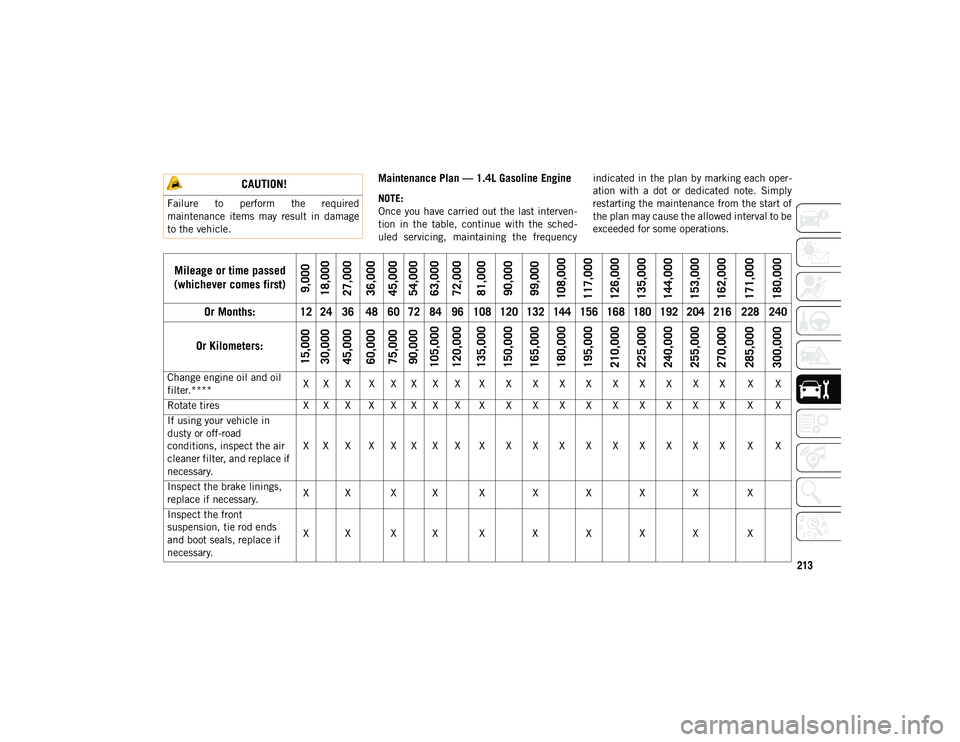
213
Maintenance Plan — 1.4L Gasoline Engine
NOTE:
Once you have carried out the last interven-
tion in the table, continue with the sched -
uled servicing, maintaining the frequency indicated in the plan by marking each oper
-
ation with a dot or dedicated note. Simply
restarting the maintenance from the start of
the plan may cause the allowed interval to be
exceeded for some operations.
CAUTION!
Failure to perform the required
maintenance items may result in damage
to the vehicle.
Mileage or time passed
(whichever comes first)
9,000
18,000
27,000
36,000
45,000
54,000
63,000
72,000
81,000
90,000
99,000
108,000
117,000
126,000
135,000
144,000
153,000
162,000
171,000
180,000
Or Months:
12 24 36 48 60 72 84 96 108 120 132 144 156 168 180 192 204 216 228 240
Or Kilometers:
15,000
30,000
45,000
60,000
75,000
90,000
105,000
120,000
135,000
150,000
165,000
180,000
195,000
210,000
225,000
240,000
255,000
270,000
285,000
300,000
Change engine oil and oil
filter.**** X X X X X X X X X X X X X X X X X X X X
Rotate tires X X X X X X X X X X X X X X X X X X X X
If using your vehicle in
dusty or off-road
conditions, inspect the air
cleaner filter, and replace if
necessary. X X X X X X X X X X X X X X X X X X X X
Inspect the brake linings,
replace if necessary. X X X X X X X X X X
Inspect the front
suspension, tie rod ends
and boot seals, replace if
necessary. X X X X X X X X X X
2020_JEEP_M6_UG_UK.book Page 213
Page 216 of 328
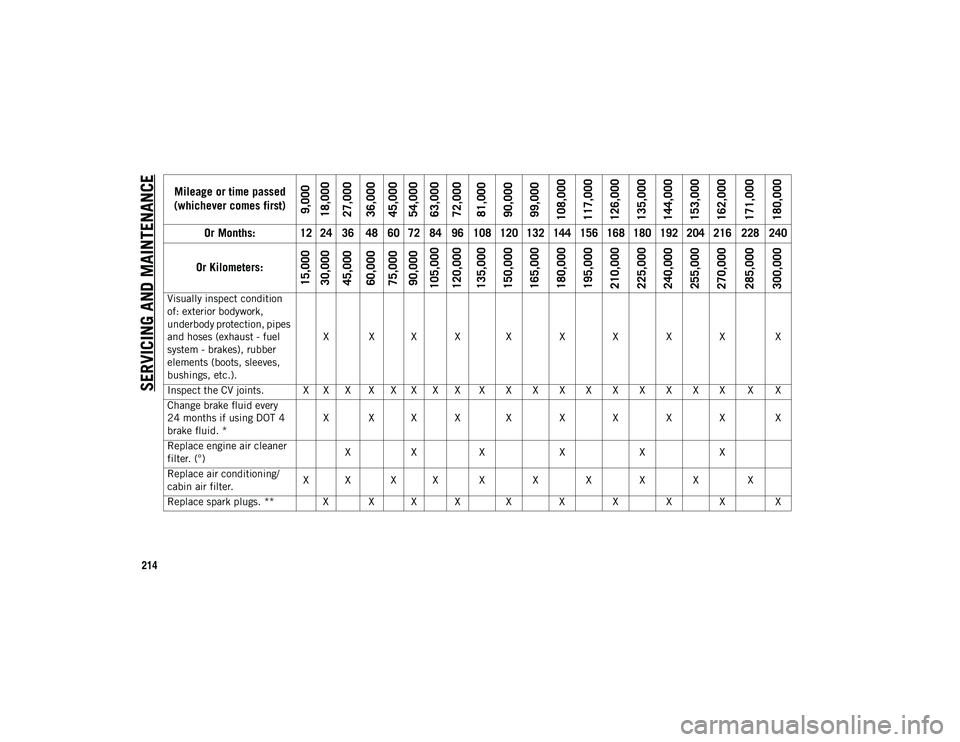
SERVICING AND MAINTENANCE
214
Visually inspect condition
of: exterior bodywork,
underbody protection, pipes
and hoses (exhaust - fuel
system - brakes), rubber
elements (boots, sleeves,
bushings, etc.).X X X X X X X X X X
Inspect the CV joints. X X X X X X X X X X X X X X X X X X X X
Change brake fluid every
24 months if using DOT 4
brake fluid. * X X X X X X X X X X
Replace engine air cleaner
filter. (°) X
X X XXX
Replace air conditioning/
cabin air filter. X X X X X X X X X X
Replace spark plugs. ** X X X X X X X X X X
Mileage or time passed
(whichever comes first)
9,000
18,000
27,000
36,000
45,000
54,000
63,000
72,000
81,000
90,000
99,000
108,000
117,000
126,000
135,000
144,000
153,000
162,000
171,000
180,000
Or Months:
12 24 36 48 60 72 84 96 108 120 132 144 156 168 180 192 204 216 228 240
Or Kilometers:
15,000
30,000
45,000
60,000
75,000
90,000
105,000
120,000
135,000
150,000
165,000
180,000
195,000
210,000
225,000
240,000
255,000
270,000
285,000
300,000
2020_JEEP_M6_UG_UK.book Page 214